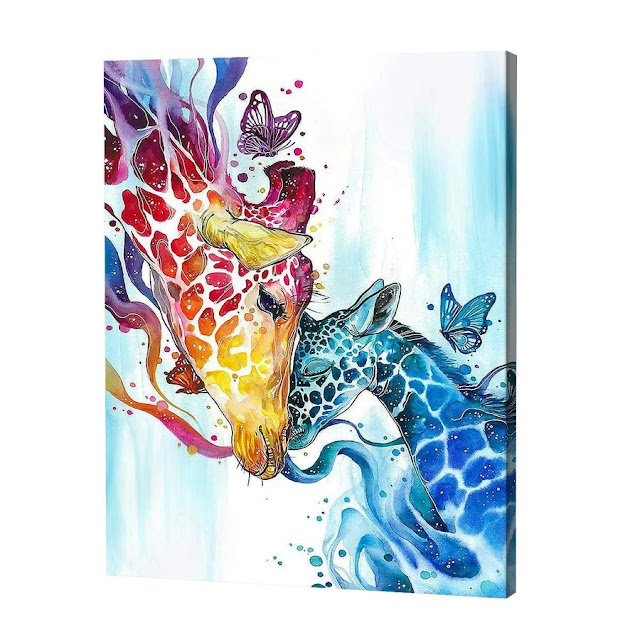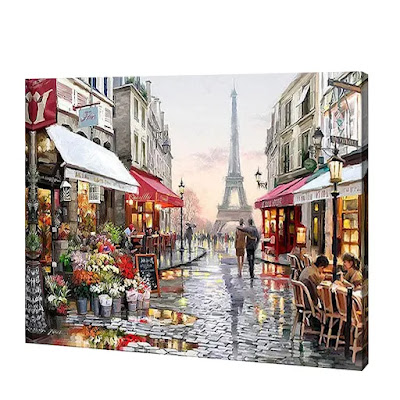Custom Diamond Painting: What You Need to Know Before Starting
Custom diamond painting has taken the world of arts and
crafts by storm, offering hobbyists a relaxing and creative way to craft
beautiful, sparkling artworks. While standard diamond painting kits provide
pre-designed images, custom diamond
painting takes it to the next level by allowing you to personalize the
artwork based on your own photographs or designs. Whether you're a beginner or
an experienced artist, creating a custom piece can be both exciting and
rewarding. However, there are a few things you should know before diving into
your custom diamond painting project to ensure success and enjoyment.
In this guide, we'll cover everything you need to know about
custom diamond painting to help you get started on the right foot.
1. Understanding What Custom Diamond Painting Is
Diamond
painting is a form of art where you apply small resin “diamonds” to a
canvas to create a mosaic-like image. Each diamond corresponds to a specific
color code, and when placed correctly, the completed painting sparkles and
shines like a gem-studded masterpiece. In custom diamond painting,
instead of using a pre-made design, you upload your own photo or image, and the
manufacturer converts it into a diamond painting kit.
Whether it's a family portrait, a beloved pet, or a favorite
landscape, custom diamond painting allows you to turn meaningful photos
into dazzling works of art. The result is a highly personalized piece that can
be cherished for years to come or even given as a thoughtful gift.
2. Choosing the Right Image for Your Custom Diamond Painting
One of the most important decisions you’ll make when
starting a custom diamond painting project is choosing the right image.
Not every image is suited for this type of artwork, so it's essential to select
one that will translate well into a diamond painting format.
Here are a few tips to keep in mind when selecting your
image:
- Resolution
Matters: The higher the resolution of your image, the better the
outcome will be. A high-quality, high-resolution photo ensures that all
the details are captured clearly, especially in larger canvases.
- Clarity
Over Complexity: Simple and clear images with bold contrasts and
larger elements tend to work better for custom diamond painting. If
your photo has too many small, intricate details, they might get lost in
translation when the image is converted into a diamond painting.
- Lighting:
Choose a well-lit image with balanced lighting. Photos that are too dark
or have heavy shadows can make it difficult to differentiate between
colors in the final artwork.
- Subject
Matter: Consider how much detail is needed for the subject. Faces, for
example, require more detail, so if you’re creating a portrait, a larger
canvas size is often recommended.
3. Selecting the Right Canvas Size
Canvas size plays a critical role in determining the quality
and clarity of your finished custom diamond painting. The larger the
canvas, the more detailed and clear the final image will be, especially for
intricate designs or images with a lot of fine details.
- Small
Canvases (30x40 cm or smaller): These are great for simple images with
minimal detail, such as close-up portraits or images with large,
easy-to-distinguish objects. However, fine details may be lost in smaller
canvases.
- Medium
Canvases (40x50 cm to 50x70 cm): These are ideal for images with
moderate detail, such as landscapes or group portraits. They strike a good
balance between detail and size, making them popular among diamond
painters.
- Large
Canvases (70x100 cm or larger): Larger canvases are perfect for
detailed images, such as family portraits or photos with multiple
subjects. The bigger the canvas, the more accurately the small diamonds
will depict the intricate details.
4. Choosing Between Round and Square Diamonds
When it comes to diamond painting, there are two main
types of diamonds: round and square. Each type offers a slightly different look
and experience, so it's important to choose the one that best fits your
preferences.
- Round
Diamonds: These are easier to pick up and place, making them ideal for
beginners. They offer a slightly softer look, as the round edges leave
small gaps between the diamonds. While they’re faster to work with, the
final product may have a slightly less polished finish compared to square
diamonds.
- Square
Diamonds: These provide a more refined and cohesive finish, as they
fit snugly together without leaving gaps. This creates a sharper, more
professional look. However, working with square diamonds can be more
time-consuming and requires greater precision.
Ultimately, the choice between round and square diamonds
depends on your personal preference and how polished you want the final result
to look.
5. Organizing Your Workspace and Materials
Before you start your custom diamond painting
project, it's important to organize your workspace and materials. Diamond
painting involves working with hundreds (if not thousands) of tiny diamonds, so
keeping them sorted and accessible is key to making the process smooth and
enjoyable.
- Diamond
Storage: Many diamond painters use small storage containers or
resealable bags to keep their diamonds organized by color and code.
Labeling each container with the corresponding color code helps you
quickly find the diamonds you need while working.
- Workspace:
Ensure you have a clean, flat surface where you can comfortably work on
your canvas. Diamond painting can take several days or weeks to complete,
so choose a space where your work-in-progress won’t be disturbed.
- Tools:
The most basic tools you’ll need include a diamond pen, a wax pad (to help
the diamonds stick to the pen), and tweezers for precision placement. Some
kits also come with a light pad to illuminate the canvas and make it
easier to see the symbols and colors.
6. Understanding the Time Commitment
Diamond painting is a time-consuming hobby that
requires patience and attention to detail. Depending on the size of your canvas
and the complexity of the image, it can take anywhere from a few days to
several weeks to complete a custom painting.
If you’re new to diamond painting, it’s important to
start with a project size that matches your comfort level. Smaller canvases are
quicker to finish and can give you a sense of accomplishment early on. As you
gain experience, you can take on larger and more complex projects.
7. Troubleshooting Common Issues
As with any craft, there may be a few bumps along the way
when working on your custom diamond painting. Here are a few common
issues and how to fix them:
- Diamonds
Falling Off: This can happen if the adhesive on the canvas starts to
lose its stickiness. To fix this, gently press the diamonds back into
place using a rolling pin. If they continue to come loose, you can apply a
small amount of fabric glue to the back of the diamonds.
- Misaligned
Diamonds: Use tweezers to adjust any misaligned diamonds. If an entire
row is misaligned, a diamond straightening tool can help keep the lines
uniform.
- Missing
Diamonds: If you run out of a particular color or lose some diamonds,
most reputable companies will offer replacement diamonds. It’s always a
good idea to keep extra diamonds from previous projects just in case.
8. Framing and Displaying Your Custom Diamond Painting
Once your custom diamond painting is complete, it’s
time to showcase your hard work! Framing your artwork not only enhances its
visual appeal but also protects it from dust and damage.
- Frame
Size: Choose a frame that fits the dimensions of your canvas. Shadow
box frames are a popular choice because they provide enough depth to
accommodate the raised surface of the diamonds.
- Glass
or No Glass: While traditional frames with glass protect the painting,
they can dull the sparkle of the diamonds. Many diamond painters opt for
frames without glass or use acrylic instead to preserve the brilliance of
the diamonds.
Conclusion
Creating a custom diamond painting is a rewarding
experience that allows you to bring personal memories or favorite images to
life in a dazzling, creative way. By understanding the basics—such as choosing
the right image, canvas size, and diamonds—you can avoid common mistakes and
enjoy the process of crafting a beautiful piece of art. With proper preparation
and organization, your custom diamond painting project will be an enjoyable and
fulfilling hobby that leaves you with a stunning masterpiece to cherish for
years to come.




Comments
Post a Comment